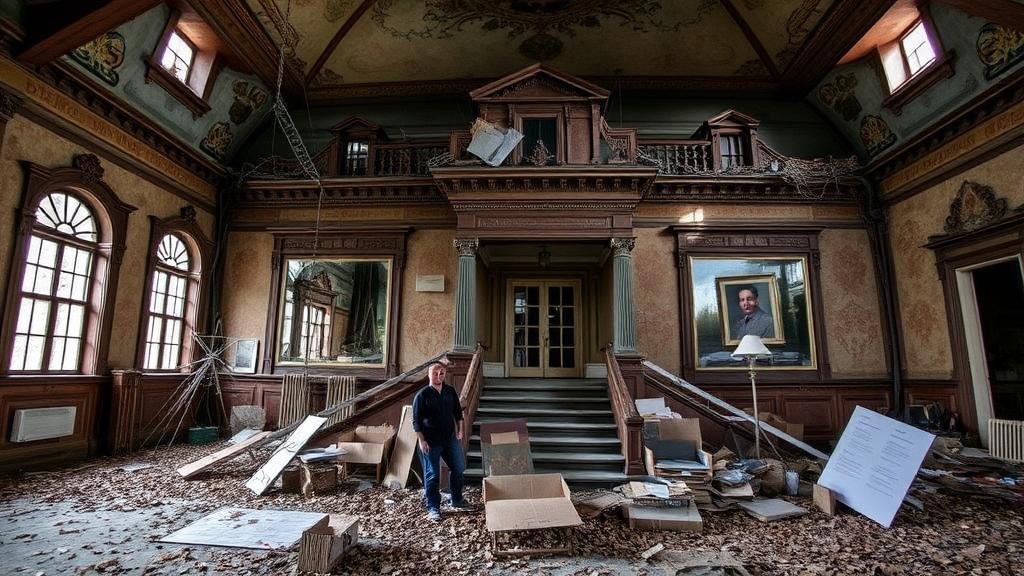Unearthing Loot in Historic Mansions Abandoned After Fires
Unearthing Loot in Historic Mansions Abandoned After Fires
Abandoned historic mansions evoke a sense of mystery and nostalgia. But, they can also become treasuries of extraordinary artifacts for those willing to explore their past. Fires often lead to abandonment, transforming once-grand homes into places of neglect. This article delves into the implications of exploring these sites, unearthing their hidden treasures, and the associated ethical and legal considerations.
The Allure of Abandoned Mansions
Historic mansions abandoned after fires frequently captivate urban explorers, salvage hunters, and historians. The dramatic stories encapsulated within their walls can enrich our understanding of previous generations while simultaneously providing tangible connections to our cultural heritage. For example, the once opulent Darlington Mansion in Pennsylvania, which suffered significant fire damage, has become a hotspot for treasure hunters and history enthusiasts alike.
Identifying Lost Artifacts
The primary objective of exploring these sites often revolves around the pursuit of artifacts and valuables obscured by debris and soot. Common finds in these mansions include:
- Antique furniture, typically crafted from dodged wood and often adorned with intricate carvings.
- Historical documents or photo collections, showcasing the lives of previous residents.
- Valuable collectibles, including porcelain, silverware, and other heirlooms that may have escaped public knowledge.
For example, the 2016 fire at the historic Mansion on Broadway led to the discovery of a trove of 19th-century glassware, which was later appraised at significant value. Archaeological recoveries like these not only salvage valuable items but also contribute to the larger historical narrative of the region.
The Immediate Impact of Fire on Historic Properties
Understanding the effects of fire on historic properties is crucial for appreciating the environment of these excavation sites. Fires can destroy not only structural elements but also the content of a home, creating a landscape where time stands still. heat can warp, displace, and char items, presenting unique challenges to treasure seekers. Also, the extent of damage can vary widely:
- Catastrophic fires that result in total loss–remnants barely visible beneath ash.
- Partial burns, leaving hidden treasures within intact areas.
Such scenarios demand different approaches towards excavation, carefully balancing preservation and recovery. It is not uncommon for treasure hunters to utilize state-of-the-art sonar tools to detect buried valuables without further damaging the fragile site.
Legal and Ethical Considerations
Engaging in treasure hunting within abandoned mansions brings forth significant legal and ethical inquiries. Possessing loot recovered from these sites can lead to complex property disputes. The principle of finders keepers often does not apply where legal ownership remains in question. Exploring these sites without proper permissions can constitute trespassing and result in criminal charges.
As a notable case, the recovery of artifacts from the historic Hutton Mansion in New York triggered a legal battle after the original owners descendants claimed the items. Such scenarios underline the importance of verifying property ownership and obtaining appropriate permissions.
Preservation of Historical Context
While it may be tempting to focus solely on value recovery, the importance of preserving the historical context must not be overlooked. A comprehensive understanding of the original architecture and history is essential for responsible excavation. Adopting methodologies from both archaeology and historical preservation can yield far richer and more meaningful insights than simple salvage.
Case Study: The Recovery at Rosewood Estate
The Rosewood Estate, a mansion abandoned in the wake of a devastating fire in 2019, serves as a poignant case study in responsible recovery efforts. site drew numerous amateur treasure hunters, prompting local authorities to establish regulations for exploring its grounds. Following the establishment of a formal excavation project, archaeologists uncovered several priceless artifacts, including:
- A grand piano nearly untouched by the fire, which provided insight into the estates past musical recitals.
- Handwritten letters and diaries belonging to the estates last resident, chronicling early 20th-century life.
This case exemplifies how collaborative efforts between locals and professionals can yield satisfying results while respecting the integrity of the site.
Actionable Takeaways
For those inspired to explore such abandoned sites, take note of the following best practices:
- Research and understand the legalities associated with the property in question.
- Engage with professionals who can provide guidance in historical preservation and excavation.
- Emphasize education over simple treasure recovery to enrich the narrative surrounding these historic properties.
To wrap up, while unearthing loot in historic mansions abandoned after fires can be exciting and potentially rewarding, it carries profound responsibilities. A meticulous approach can lead to fruitful discoveries not just in terms of material wealth but also valuable historical knowledge. Understanding this balance is essential for anyone considering entering this intriguing realm of exploration.



